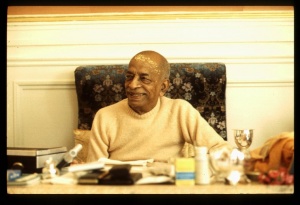CC Antya 2.16 (1975): Difference between revisions
(Vanibot #0027: CCMirror - Mirror CC's 1996 edition to form a basis for 1975) |
(Vanibot #0020: VersionCompareLinker - added a link to the Version Compare feature) |
||
| Line 2: | Line 2: | ||
<div style="float:left">'''[[Sri Caitanya-caritamrta (1975)|Śrī Caitanya-caritāmṛta (1975)]] - [[CC Antya (1975)|Antya-līlā]] - [[CC Antya 2 (1975)|Chapter 2: The Chastisement of Junior Haridāsa]]'''</div> | <div style="float:left">'''[[Sri Caitanya-caritamrta (1975)|Śrī Caitanya-caritāmṛta (1975)]] - [[CC Antya (1975)|Antya-līlā]] - [[CC Antya 2 (1975)|Chapter 2: The Chastisement of Junior Haridāsa]]'''</div> | ||
<div style="float:right">[[File:Go-previous.png|link=CC Antya 2.15 (1975)|Antya-līlā 2.15]] '''[[CC Antya 2.15 (1975)|Antya-līlā 2.15]] - [[CC Antya 2.17 (1975)|Antya-līlā 2.17]]''' [[File:Go-next.png|link=CC Antya 2.17 (1975)|Antya-līlā 2.17]]</div> | <div style="float:right">[[File:Go-previous.png|link=CC Antya 2.15 (1975)|Antya-līlā 2.15]] '''[[CC Antya 2.15 (1975)|Antya-līlā 2.15]] - [[CC Antya 2.17 (1975)|Antya-līlā 2.17]]''' [[File:Go-next.png|link=CC Antya 2.17 (1975)|Antya-līlā 2.17]]</div> | ||
{{CompareVersions|CC|Antya 2.16|CC 1975|CC 1996}} | |||
{{RandomImage}} | {{RandomImage}} | ||
==== TEXT 16 ==== | ==== TEXT 16 ==== | ||
| Line 18: | Line 17: | ||
<div class="synonyms"> | <div class="synonyms"> | ||
āmbuyā-muluke—in the province known as Āmbuyā; | āmbuyā-muluke—in the province known as Āmbuyā; haya—here is; nakula-brahmacārī—a person known as Nakula Brahmacārī; parama-vaiṣṇava—a perfectly pure devotee; teṅho—he; baḍa adhikārī—very advanced in devotional service. | ||
</div> | </div> | ||
| Line 32: | Line 31: | ||
<div class="purport"> | <div class="purport"> | ||
Śrīla Bhaktivinoda Ṭhākura says that Āmbuyā-muluka is the present Ambikā, a city in the Vardhamāna district of West Bengal. Formerly, during the | Śrīla Bhaktivinoda Ṭhākura says that Āmbuyā-muluka is the present Ambikā, a city in the Vardhamāna district of West Bengal. Formerly, during the Mohammedan regime, it was known as Āmbuyā-muluka. In this city there is a neighborhood called Pyārīgañja, and that is where Nakula Brahmacārī used to live. | ||
</div> | </div> | ||
Latest revision as of 00:15, 27 January 2020

His Divine Grace
A.C. Bhaktivedanta Swami Prabhupada
A.C. Bhaktivedanta Swami Prabhupada
TEXT 16
- āmbuyā-muluke haya nakula-brahmacārī
- parama-vaiṣṇava teṅho baḍa adhikārī
SYNONYMS
āmbuyā-muluke—in the province known as Āmbuyā; haya—here is; nakula-brahmacārī—a person known as Nakula Brahmacārī; parama-vaiṣṇava—a perfectly pure devotee; teṅho—he; baḍa adhikārī—very advanced in devotional service.
TRANSLATION
In Āmbuyā-muluka there was a person named Nakula Brahmacārī, who was a perfectly pure devotee, greatly advanced in devotional service.
PURPORT
Śrīla Bhaktivinoda Ṭhākura says that Āmbuyā-muluka is the present Ambikā, a city in the Vardhamāna district of West Bengal. Formerly, during the Mohammedan regime, it was known as Āmbuyā-muluka. In this city there is a neighborhood called Pyārīgañja, and that is where Nakula Brahmacārī used to live.